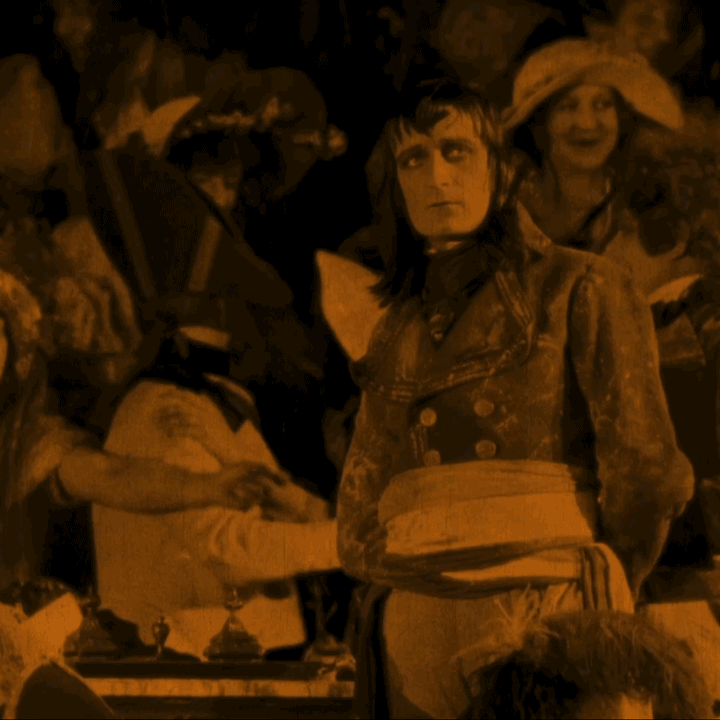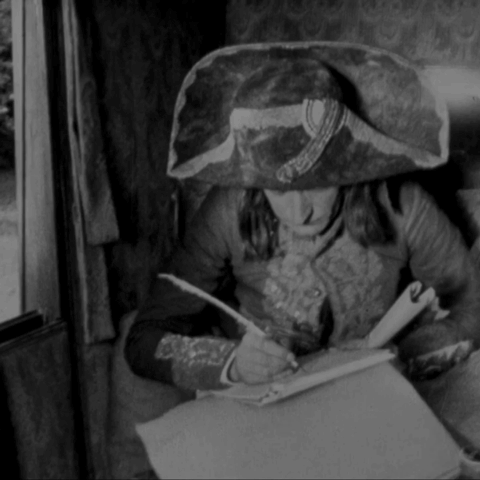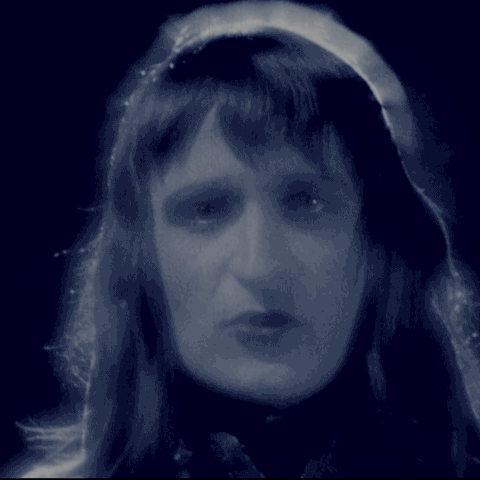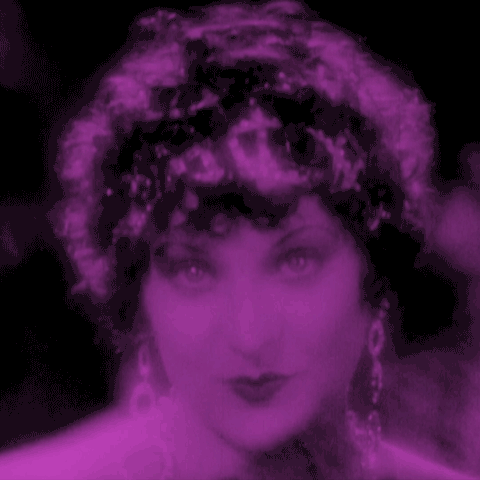NAPOLEON, ABEL GANCE, GAUMONT, 1927, 330 MINUTES.

I’m publishing the occasional post from my newsletter about the history of film here on the blog. This one concerns the biggest international release of 1927. Not the biggest Hollywood release – that was The Jazz Singer. I’m reviewing that one separately. I really didn’t think I should miss the Napoléon opportunity, though, what with the Ridley Scott version soaring up the charts as we speak and everything. And this one is a very special film.
To start with, what is this film? It’s a biopic, it’s a love story, it’s pure mythography. It’s not a history. It runs to five-and-a-half hours but stops before we get to fully Continental Napoléon. In fact, he’s 27 when the film ends and still a second-ranking General making a name for himself in Italy. Gance wanted to finish the story but the talkies killed the project (the biggest Hollywood film of the same year was The Jazz Singer). We also wonder how on earth he’d have captured the peaks and troughs of the Emperor’s mighty narrative arc when he’s already given us the most dazzling, 4:1 wide-screen finale yet seen in a cinema.

What else? Continental Napoléon is present – he’s foreshadowed in a kind of dream-sequence speech he makes to all the dead revolutionaries in the empty hall of the Convention. Dead Marat asks “what are your plans, Napoléon?” and he replies “…the liberation of oppressed peoples, the fusion of great European interests, the suppression of frontiers… THE UNIVERSAL REPUBLIC!” This is the Napoléon loved by Beethoven and Goethe – but, if we’re honest, we know already that when he says ‘republic’ he means something more like “you know, a kind of Empire with a single, unquestioned Alexander-the-Great-type leader…” We learn also of his dastardly totalising ambitions for a European super-state with the free movement of persons and presumably nice burgundy Napoleonic passports – “Europe will beome a single people, and anyone, wherever he travels, will always find himself in a common father-land.”

Also, he’s lovelorn, passionate, more self-confident than the most self-confident person you’ve ever met. Generals hardened by revolution and women by the Terror crumble before him. Within minutes of his arrival at the chaotic HQ of the Italian campaign (“the Army of Italy, without food, without clothes and without discipline”), all the grizzled Generals who’d made it clear in advance that they wouldn’t let the Corsican wipe their boots are doffing their huge, dusty hats to the new boss. One of them puts it well: “with his piercing eyes, this little stump of a man frightens me.”
Albert Dieudonné, playing the stump of a man, concerns himself with Napoléon’s authority, with his staggering resilience, his imperious, outsider presence but also with his fragility (the child actor chosen for the school scenes, Vladimir Roudenko, somehow musters the same wobbly-lower-lip grandeur – bullied but never bowed – we are already sobbing in the first reel).
History v biopic
And now some historiography. At the time of this film’s release a group of young historians in France was getting ready to turn the whole discipline upside-down. Led by Fernand Braudel, they wanted to find the long-term patterns in the histories they were telling by pulling back (zooming out?) from the stream of events and the personalities to focus on what they called the ‘longue durée’. This approach aimed to put the actions of historic figures into the social, economic and technological context and inevitably reduced the importance of individual actors – essentially the opposite of the ‘great man’ model of history that had dominated until the 20th Century (and that still dominates in more parochial British history writing).

For these historians, mostly direct contemporaries of Gance, all the conditions for a Napoléon to emerge already existed in the late 18th Century and if the coarse kid from Corsica hadn’t come along to fill the role, somebody else would have done. It’s safe to assume that Gance (and Ridley Scott) would not tolerate this very dry understanding and would rather die than demote their lead characters to mere instruments of world history. To be honest, it’s not what we want from our biopics either. This Napoléon must bestride history, colossus-like, not obey its logic.
Get on with it Gance!
Gance’s canvas is vast – he gives himself almost three standard-length features to tell the story of Napoléon’s first 27 years. Consequently, from time to time, the action slows from magisterial to ponderous. The first major battle – the siege of Toulon – where Napoléon overcomes a lazy and decadent French command and a complacent English one to take back the impregnable port, takes almost an hour. We’re given half an hour of continuous moping and adoring from afar as Napoléon develops his bid for the love of Joséphine de Beauharnais, widowed tragically during the Terror but obviously enjoying the single life in revolutionary Paris where, by the look of it, anything goes. Our hero is even trained in the art of courtship by star of the Comédie-Française (and hair innovator) Talma. The party scenes in this section of the film are like something from the Great Gatsby – there’s nudity and drunkenness – a near-orgy. We fall through a flapper wormhole and spend 15 minutes in another Paris.

And the object of Napoléon’s desire is a complicated woman. We’re asked to admire Joséphine’s canny navigation of the post-revolutionary hierarchy, her careful use of the elite men who fall at her feet. She is very much in control of her destiny and in no way a sure thing, even for leading suitor and man-of-the-moment Napoléon Bonaparte. Where another woman of her status – a single mother in her thirties who had only narrowly avoided the guillotine – might have yielded to Napoléon’s advances when he saved Paris from the Royalists in 1795, she holds him off until the following Spring (cue moping and adoring from afar). Hers is a character I’d love to have seen Gance develop in the sequels (Anita Brookner puts it in terms we understand: “Josephine, flirting heavily with her fan, is a vamp.”).
Split-screen destiny

It’s not easy to decompose this movie into the standard three acts of the hero’s journey. And besides, the final act would surely belong to the next film in the sequence – part five – which was never made (and, spoiler alert, it wouldn’t have ended well). But this film’s final act is the most spectacular by far and for audiences at the end of the twenties, who didn’t want for spectacle after all, in the era of De Mille, Chaplin and Griffith, it must have been enormously exciting.

Gance and his cinematographer Jules Kruger lash together three cameras and produce something as grand as Cinemascope – twenty years before it becomes widespread – but also something that in its complexity makes ‘scope look like something primitive – a crude smearing of the image across the visual plane when set against Gance’s profound spectacle of relatedness and contrast.

And once they’ve invented the device (a critic named it Polyvision), they play with it and insert shots to create sliding and rotating tableaux as rich as a work by any contemporary IMAX artist. In one scene, Napoléon, on horseback, is flipped horizontally to provide left- and right-hand bookends to a central shot of dusty soldiers marching to their fate – it’s sophisticated storytelling but also emotionally complex – a tableau not just of events but also, somehow, of juxtaposed, contrasted and reinforcing affect. It’s a disorienting, almost delirious experience soaking up all this action – and on so many levels. In this final section, which is half an hour long, the narrative is set aside almost entirely, in favour of this unarguably new language – of spectacle but also of kaleidoscopic emotional drama – never still. I couldn’t tell you the order of events here, only that I was in awe throughout.
- I’d love to know more about young Bonaparte Vladimir Roudenko. Looks like he never made another film and died in Paris in 1976 but there’s little else online.
- One admiring British historian, of the more orthodox kind, has called Bonaparte ‘the enlightenment on horseback’. Hegel once saw him in person and wrote later “I saw the Emperor – this world-soul – riding out of the city on reconnaissance. It is indeed a wonderful sensation to see such an individual, who, concentrated here at a single point, astride a horse, reaches out over the world and masters it.”
- The 335-minute restoration that’s on Amazon Prime and on Blu-Ray is essentially the 1981 Kevin Brownlow restoration, digitised in 2016. If you search the archives you’ll find plenty of reviews of the 1981 release in the smart papers. Brownlow’s extraordinary achievement in locating and then putting together coherently the film’s scattered fragments was recognised. It’s a masterpiece in itself. The best review I’ve read from that cycle is Anita Brookner’s in the LRB.
- I really shouldn’t have left the music out of this review. The 1981 score is by Carl Davis and it’s a work of art in itself – linking Beethoven’s Eroica in multiple variations and a dozen other mostly French composers of the period with specially-composed material. Davis conducted the score live in the cinema for the restoration’s all-day premiere. I cannot think of a more stressful and exhausting task.
- Jules Kruger, who photographed this extraordinary film, made dozens more and worked for over twenty years in the sound era too, all around the world.
- Sign up for GROSS, my email newsletter journey through the history of cinema. There’s a free option for you cheapskates.
- Here’s a list of all the top-grossing films since 1913 and here’s my Letterboxd list.
- And here’s another top-grossing list.
